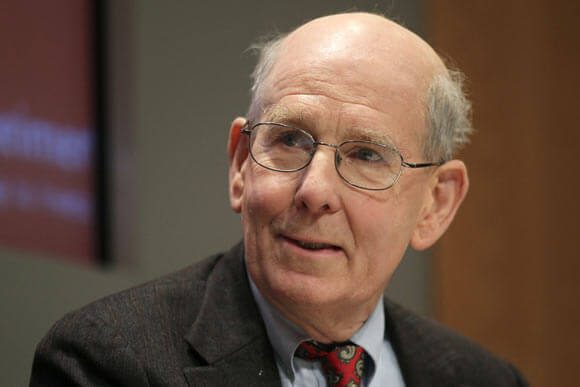Top Economist Who Predicted 2008 Housing Crash Says The Commercial Real Estate Bubble Is About To Burst
The pandemic has impacted various aspects of our lives. Although many activities have resumed, such as traveling and gathering, work environments have changed significantly. The traditional office buildings are mostly empty, and central business districts have been adversely affected. The commercial real estate sector is still reeling from the massive shift towards remote or hybrid work, resulting in a reluctance to retain brick-and-mortar properties when e-commerce provides more accessible alternatives. It’s puzzling that while traffic to downtown business districts has more than recovered, people are still hesitant to return to offices.

Gary Shilling, a well-known economist, has predicted that the commercial real estate market is on the verge of a bubble burst
There have been indications for some time that the commercial real estate market is a bubble on the point of bursting. We Work’s filing for bankruptcy earlier this month was a warning sign, as the co-working company immediately began to terminate dozens of leases in New York City alone.
A well-known Wall Street forecaster has expressed concern that the entire market is on the point of collapse.
Gary Shilling, an economist well-known for accurately predicting the 2008 housing crash, recently stated on the investing podcast The Julia La Roche Show that he believes the most significant bubble currently is commercial real estate. Although he clarified that this is not as severe as the subprime mortgage crisis that caused some Wall Street banks to collapse and triggered the global financial crisis, he thinks a bubble is starting to burst.
Before the crash, a housing market expert warned about the dangers of subprime loans, considered the most significant financial problem for the US economy. In January 2006, the expert-authored an article titled “The Housing Bubble Will Probably Burst.” Today, the expert, A. Gary Shilling is the president of a financial consultancy, A. Gary Shilling & Co. Inc. and also serves as the editor of A. Gary Shilling’s Insight is a monthly newsletter offering exhaustive investigations of key economic indicators and their impact on investment portfolios.
During an interview with La Roche, Shilling discussed remote work and how he dealt with commuting. He mentioned that he had already found a solution to the commuting problem by moving his company’s office from the busy areas of lower Manhattan to suburban New Jersey back in 1990.
He further added that there are currently many vacant office buildings, which pose a problem as their mortgages are coming due. Mortgage lenders may either decline to renew the loans or charge significantly higher interest rates.
The office sector is a significant indicator of a struggling commercial real estate market:
The commercial real estate collapse has hit the office sector the hardest, per a report by real estate firm Cushman & Wakefield. The report reveals that the vacancy rates are around 1.5 times higher than at the end of 2019. Moreover, the United States could have as much as 1 billion square feet of unused office space by the decade’s end. According to Moody’s Analytics, the office vacancy rate of 19.2% this quarter is perilously close to the record-high vacancy rate of 19.3% observed in 1986 and 1991.
According to a report by Allianz Trade economists in late October, while specific properties such as shopping malls or retail have some protection due to prior devaluations due to the rise of e-commerce, the office segment has been severely impacted. The report states that higher interest rates have made properties less attractive than risk-free government bonds, leading to a significant decline in asset values.
Some economists believe that commercial real estate market recovery could take years due to higher delinquency and interest rates.
“According to Stijn Van Nieuwerburgh, a Columbia Business School real estate and finance professor, the office market may take several years to stabilize. In October, Goldman Sachs released its Commercial Real Estate Risks report, in which Van Nieuwerburgh described the situation as “a trainwreck in slow motion.”
“It’s not just the office sector facing difficulties,” says Shilling. “Other commercial real estate sectors such as hotels and shopping centers have also been struggling for some time.” This impending crash in commercial real estate is a sign of a struggling economy. Shilling predicts the S&P may fall to its lowest level since the pandemic began. He also believes that a recession might be on the horizon, or we may already be experiencing it, as “nobody rings the bell.”
“I have thought that stocks would decline by about 30% to 40% from peak to trough,” he said on the podcast. “If you look at many of the major indicators that reliably predict recessions, it’s pretty hard to avoid the conclusion that a recession is imminent.”
Erin Sykes, the chief economist at the residential real estate brokerage firm Nest Seekers International, agrees with Shilling that commercial spaces have been struggling to pay rent on time.
According to a statement given to Fortune, underutilized malls and retail spaces are the primary cause of delinquencies in real estate. The challenging commercial landscape affects large cities, although it’s important to remember that real estate is local. Delinquency rates for commercial mortgages, including office, multifamily, and other commercial properties, have been rising continuously for four quarters, per the Mortgage Bankers Association (MBA). During the third quarter, more than 5% of office property loans and another 5% of retail loan balances were delinquent.
According to Jamie Woodwell, the head of commercial real estate research at MBA, commercial property markets face difficulties due to the uncertainty surrounding the fundamentals of some properties. There is also a need for more transparency in current property values and higher and volatile interest rates. As a result, there has been a gradual increase in delinquency rates, mainly among loans that are facing more of these challenges.
While Shilling did not specify the exact timing of the bubble burst, some believe it may occur sooner than anticipated.
Likely, it is already taking place, “ Sykes claims. In September, real estate magnate Jeff Greene, who made an approximately $800 million fortune by betting against the housing bubble in the mid-2000s, stated that we are only in the early stages of a commercial real estate decline.
During an interview with CNBC, Greene predicted that the current correction was just the beginning, stating, “I hate to say it.”


